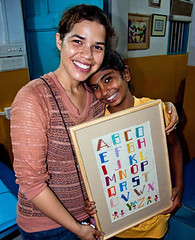
A female soldier shows the two items she always carries on her body: a cross and a hunting knife.
“You always have protection with Jesus,” she says, “but sometimes you need just a little bit more.”
Similarly, another female soldier explains, “[My] knife wasn’t for the Iraqis… it was for the guys on my own side.”
For this year’s Veterans Day, I wanted to acknowledge the efforts of women soldiers. More than any time before in history, women are serving in the armed forces. According to 2007 estimates, women made up 15 percent of active duty forces in the Iraq War, four times more than in the 1991 Gulf War.
And while many women have happily served in the U.S. armed forces, forging noteworthy careers in service to their country, it is also estimated that over 20 percent of female veterans have been sexually assaulted during their service. And it is quite possible the real figures are much higher.
Sexual assault of fellow soldiers is the U.S. military’s dirty secret. The 2012 Sundance winning film, The Invisible War, documents the rampant epidemic of sexual assault of soldiers by their own comrades, and the military’s systematic policy of covering up most such cases. The film captures the voices and experiences of women soldiers (as well as some men) in all branches of the armed services – women who were not only assaulted by those pledged to be their ‘brothers in arms’, but unable to seek justice due to the military’s internal handling of such cases. Watch the film trailer:
Over and over again, women in the film describe entering the armed services due to family tradition, dreams of honor, professional camaraderie, and public service, only to be treated as second-class citizens (“walking mattresses”) by their fellow soldiers. Women describe being harassed, ridiculed, isolated, and yes, assaulted. They describe being afraid to walk alone through their bases, afraid to go to the latrine at night, afraid to go into the room of a superior when summoned. Women describe being attacked, drugged, beaten, repeatedly raped, and then told by higher ups to “deal with it” or risk demotion, further harassment, or even facing charges themselves for everything from adultery (if their assailant was married) to conduct unbecoming an officer to court-martial. Women describe being unable to remove themselves from unsafe situations, being unable to access mental or other health services, being unable to even receive VA benefits for injuries received from their assaults.
The military’s culture of silencing and retaliating against those who report rape only exacerbates the trauma of the assault. As The Invisible War documents, many assault survivors are so traumatized, they quit the military (‘Go AWOL’), and receive dishonorable discharges – therefore disqualifying themselves from Veterans and other benefits. They may suffer more PTSD (Post-Traumatic Stress Disorder) than soldiers returning from war, becoming homeless, alcoholic, drug dependent, and, with all too much frequency, actively suicidal.
It was journalist and Columbia University journalism professor Helen Benedict who first broke this story in a 2007 Salon.com article called “The private war of women soldiers.” The article, based on interviews of 20 female Iraq war veterans, and Benedict’s subsequent book, The Lonely Soldier: The Private War of Women Serving In Iraq point to the military’s long history of covering up sexual misconduct, from the Tailhook incident in 1991 to Aberdeen in 1996. According to Benedict:
A 2003 survey of female veterans from Vietnam through the first Gulf War found that 30 percent said they were raped in the military. A 2004 study of veterans from Vietnam and all the wars since, who were seeking help for post-traumatic stress disorder, found that 71 percent of the women said they were sexually assaulted or raped while in the military. And in a third study, conducted in 1992-93 with female veterans of the Gulf War and earlier wars, 90 percent said they had been sexually harassed in the military, which means anything from being pressured for sex to being relentlessly teased and stared at.The burning question, of course, is why? Why is there such a culture of sexual assault in the U.S. military?
As an ex-military colleague recently said to me, “In the military, your body is not your own, it is the property of the U.S. government.”
To read the rest of this essay, please visit Adios, Barbie












